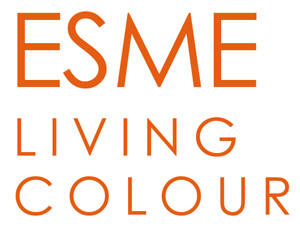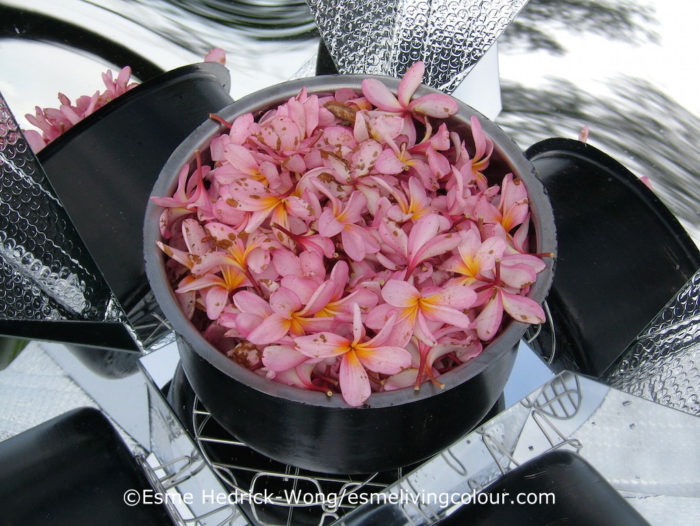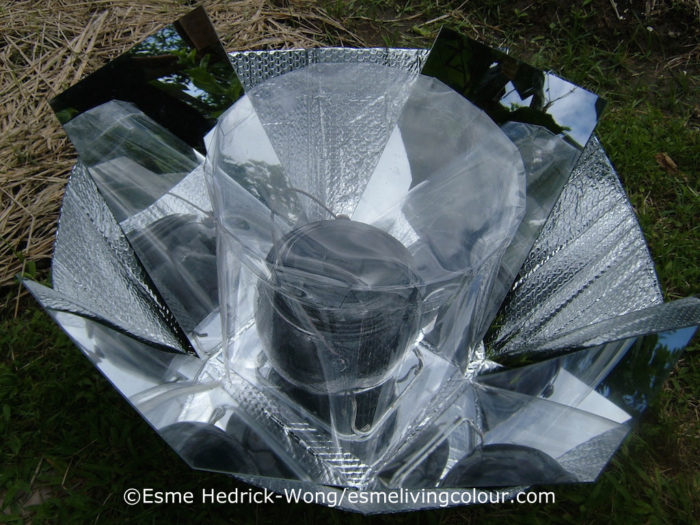ENVIRONMENT
How to protect our environment? Answers to this question are becoming more complicated. Many stock answers previously held to be self-evident are being challenged and re-examined and there is much debate on how to get it right. Strange as this may sound, natural dyes, thought to be environmentally friendly, need to be included in this debate. Two key issues of concern are how natural dyes are harvested and the serious consequences resulting from the addition of toxic additives to a natural dye bath. These issues plus the benefits of solar cooking are discussed here in more detail.
Solar Cookers: Eliminate the Need for Fire Wood and Expensive Cooking Fuels
I was inspired to design a natural dye solar cooker after visiting natural dyers in remote villages across Asia. In such places cooking fuels, such as, wood, kerosene, natural gas or electricity are difficult to obtain and expensive. These weavers and dyers, understandably, did not want to use their costly fuel resources for natural dyeing. This meant they would only use cold-water dyes, thereby limiting their choice of dye colours. Solar cooking overcomes these dye restrictions, with the added benefit that these cookers can also be used for cooking food, thus further reducing the need for expensive fuels.
By using a solar cooker the dyer no longer needs to stand over a hot stove making dye extracts. A dye extract can be put in a solar cooker in the morning and then checked on later in the day. Sometimes I would leave an extract in a solar cooker all day or even a few days, if I thought a dye material could release more pigment from long periods of simmering.
Certain dye recipes are temperature specific and require a dye bath to stay below 50°C in order to produce a certain colour. Low cooking temperatures are difficult to achieve, unless you have a wood burning fire. An electric or gas stove’s minimum cooking temperature is 70°C and even electric slow cookers maintain a cooking pot between 60°C to 80°C. A solar cooker, however, has a more flexible temperature range. It can keep a pot simmering at 80°C to 95°C, but it can also maintain a dye pot at 40°C or 50°C just by taking away some of the mirrors.
When the dye extract has reached the depth of colour desired it is strained and placed back into the dye pot. Yarn or fabric is then added to this dye and a desired temperature is maintained until the yarns have absorbed a maximum amount of colour.
Due to its circular design, this solar cooker captures the sun’s rays as it moves across the sky, eliminating the need to keep shifting the cooker in the direction of the sun. The added benefits of this cooker is that it takes less than an hour to make, the cost of materials for such a cooker are minimal, it can be easily folded up and stored away, and it’s waterproof so it can stay out in the rain if the weather suddenly changes.
Harvesting Natural Dyes
Conserving the world’s dwindling resources is an important issue and needs to be taken into account when it comes to choosing which natural dyes to use. Craft dyers who have a garden can get great satisfaction from growing their own natural dyes. Collecting dye materials in the wild requires appropriate selectivity and in-depth knowledge about which plants are endangered. Many natural dyes come from roots, bark or wood which can kill the plant or tree. If you are obtaining these materials from dye suppliers it is difficult to know if they have been harvested in a sustainable manner. For this reason I began developing new dye recipes that use only fruit rinds, husks, and fallen leaves. I have been delighted to discover a whole new range of dye materials that cost nothing and produce richer colours than many of the traditional dye sources made with bark, wood or roots.
Natural Dyes and Toxic Dye Additives
After extensive research on natural dyeing I discovered to my dismay that toxic additives are commonly used to produce a full colour spectrum. This was very disappointing as the common perception about natural dyeing is that it’s non-toxic to the dyer and environmentally friendly. Dye materials collected from plants, trees, vegetables or insects are biodegradable and the bi-products of natural dyeing can be turned into excellent garden compost. However, what most people don’t realize are the environmental and health hazards associated with the numerous ingredients that are often added to both natural and synthetic dye baths, such as heavy metals like copper, chrome, tin, and zinc or sodium hydrosulfite, thiourea dioxide, sulfuric acid, urea crystals, ammonia and bleach. In spite of these hazards, dye masters have used many of these additives for hundreds of years.
My aim is to make natural dyeing free of these bio-accumulating and bio-magnifying heavy metals or toxic additives. Finding recipes that do not require their use has proved to be difficult. Red dye recipes made from the lac insects, Kerria lac or Kerria chinensis, typically need the addition of tin. Tin is also used with natural dyes to create colours such as orange and bright yellow. Black dye recipes often require the addition of chrome, copper or tin or a combination of these three heavy metals. Rich chocolate brown dyes are generally produced with the addition of chrome and copper. Adding copper to a dull green dye bath can instantly turn it into a vibrant lime yellow or a bright grass green, two colours that are rarely achieved with natural dyes alone.
The hazards created by these heavy metals, such as copper (copper sulfate), chrome (potassium dichromate), tin (stannous chloride), and zinc, once they are released into sewage systems and waterways cause long-term environmental problems. If these metals are directly released into waterways they begin to bio-accumulate and then biomagnified as they pass through the food chain, first by contaminating plankton that are eaten by small fish, which in turn are eaten by larger fish, and then eaten by birds or humans. At each step in the food chain the dose of toxic metals becomes bigger. Even after heavy metals have gone through a wastewater treatment plant they do not break down and end up contaminating waste sludge. In the United States and in many parts of Europe waste sludge was released directly into oceans and waterways up until 1992. The U.K. only banned this practice in 1998.
Disposal of waste sludge also includes incineration. Incinerated sludge is then dumped in landfills or spread directly on agricultural land and forests. These methods are costly and do not get rid of heavy metals or toxic chemicals but instead they are transferred into the air and soil, contaminating plants or surface and ground water. There are methods of removing heavy metals from waste sludge but governments rarely implement them because they are prohibitively costly. The best solution is for governments to stop industries from discharging heavy metals or chemicals into waterways or sewage systems and to mandate that they take on the responsibility to safely dispose of them.
After learning about the affects of these toxic additives I was determined not to use them in any of my natural dye processes. I was left with only one option, to create new recipes through trial and error that do not require these ingredients. It has been a time consuming and often repetitive process. Fortunately I enjoy this kind of challenge. Some recipes took a few weeks to develop and some took years.
For more information about some of the toxic additives that are used for dyeing textiles please read on.
Adverse health effects resulting from high concentrations of copper (copper sulphate) include nausea, vomiting, abdominal pain, liver and kidney damage and anemia. The World Health Organization (WHO) recently published studies conducted with rabbits, which suggested a link between copper in the water and Alzheimers.
The compound tin (stannous chloride) has additional hazards as it transforms into hydrochloric acid once it is added to a hot dye bath. Hydrochloric acid is corrosive and can cause burns to skin and eyes. Inhaled fumes can affect the lungs causing wheezing, shortness of breath, coughing and thoracic pain. Ingestion may be fatal. If released into the soil it can leach into groundwater. Hydrochloric acid is also lethal to fish and aquatic organisms.
Chrome (potassium dichromate), is a compound that can cause many serious ailments. Material Safety Data Sheets (MSDS) provided by chemical companies to customers, warn of burns to the skin and burns to nasal passages through inhalation. Other health hazards include allergies, skin ailments, respiratory problems and nerve damage. Chrome is a carcinogen and has been well documented for causing lung and gastrointestinal cancer. It is also suspected of causing impaired fertility and harm to foetuses. The wastewater of a dye bath with the addition of chrome is highly toxic to aquatic organisms.
Sodium hydrosulfite is another dye ingredient (often used as an additive in indigo dyeing), that emits sulfur dioxide gas in a dye bath even in low concentrations; and it can exacerbate many respiratory diseases, such as asthma. Inhalation of sodium hydrosulfite dust can damage the nose, throat, or lungs and can even cause pulmonary edema (fluid in the lungs). Protective clothing and goggles are required as a safety precaution when using sodium hydrosulfite in dyeing. Contact with skin can cause burns or skin allergies resulting in a rash. Contact with eyes can cause permanent eye damage. Sodium hydrosulfite is classified as hazardous and can self-heat causing spontaneous combustion with the addition of moisture or water in the storage container. The environmental hazards of using sodium hydrosulfite have not yet been fully established; in particular what level of concentrations in the waterways will affect aquatic life. How sodium hydrosulfite interacts with other chemicals is also a concern, for example, if it is mixed with other acids certain toxic gases are created.
These are just a few examples, and the list continues for hazardous ingredients that are added to natural dye baths, all raising heath and ecological concerns. A more comprehensive list would include thiourea dioxide (Spectralite), sulphuric acid, zinc, ammonia and urea crystals. Thiourea dioxide, like sodium hydrosulfite, is a spontaneously combustible substance that creates sulphur dioxide gas and has been classified as hazardous. Inhalation of it from a dye bath can cause respiratory irritation. Inhalation of it in powder form can cause delayed pulmonary edema (accumulation of fluid in the lungs). Safety goggles and protective clothing & rubber gloves are necessary when using it.
Sulfuric acid, another common additive in natural dyeing is highly corrosive and can cause severe burns to all parts of the body. Contact with the eyes can cause blindness. Inhalation can damage mucous membranes and the upper respiratory tract. Long-term exposure to sulphuric acid mist and vapours can cause permanent damage to the lungs and teeth and more seriously it can cause cancer. The industrial production of sulphuric acid, by emitting sulphur dioxide into the air, causes environmental damage by creating acid rain, in turn, adversely affecting plant and aquatic life by lowering the pH in waterways for extended periods of time. Sulphuric acid, if disposed directly into the waterways or oceans, is lethal to aquatic life.
Zinc-Lime indigo dye vats have been in use since 1845. Zinc dust is a fine powdered heavy metal. Protective equipment is needed when handling this compound as the dust can irritate eyes or cause skin inflammation. Inhaling the dust can irritate the respiratory track, causing coughing and shortness of breath. Depending on the amounts that are inhaled symptoms that are known as metal fume fever or ‘zinc shakes’ can occur, including chills, fever, muscular pain, nausea and vomiting. Zinc poisoning causes a sweet taste in the mouth. If disposed directly into waterways or the ocean, zinc, similar to copper, chrome and tin, does not break down but bio-accumulates and biomagnifies as it passes through the food chain building up toxic concentrations.
For centuries ammonia was a key ingredient, obtained through the fermentation of urine, for preparing an indigo dye vat. Ammonia is a compound consisting of nitrogen and hydrogen that occurs naturally from the fermentation of nitrogenous animal and vegetable matter. Fermented urine was later replaced by fermenting urea crystals dissolved in water. This method of synthesizing ammonia was discovered in 1909 by the famous German physical chemist, Fritz Haber. Ammonia gives off strong and unpleasant fumes that can cause headaches, nausea, vomiting, coughing, laryngitis, wheezing, and shortness of breath; diluted solutions of ammonia, between 10 to 15% by weight, is corrosive. Repeated skin exposure can cause dermatitis. Ammonia transforms into carcinogenic compounds called chloramines and hydrazine when interacting with household cleaning products such as bleach. Ammonia is highly toxic to aquatic animals and is classified as dangerous to the environment.
For more information about the health of our waterways and oceans and ways to keep them clean here is a list of recommended reading.
- De Villiers, Marc (1999) Water: The Fate of Our Most Precious Resource, Mariner Books, U.S.A.
- Outwater, Alice (1996) Water: A Natural History, Basic Books, New York, New York
- Spinosa, Ludovico (Editor) (2007) Wastewater Sludge: A Global Overview of the Current Status and Future Prospects, IWA Publishing for Water 21
- Stauffer, Julie (1999) The Water Crisis: Finding the Right Solutions, Black Rose Books, Montreal, Canada
- Stauffer, Julie (2004) The Water You Drink: Safe Or Suspect?, New Society Publishers, Gabriola Island, Canada
- Todd, Nancy Jack & Todd, John (1993) From Eco-Cities to Living Machines: Principles of Ecological Design, North Atlantic Books, Berkeley, California
- Solar cooking Frangipani flowers
- The first step in making a solar cooker is to paint the outside of your pot black
- The solar cooker is then set up in a sunny spot. The pot is filled with natural dyes & water and then placed on a metal cook stand.
- The pot is covered with the lid
- A plastic cylinder cover, made from a sheet of clear plastic, is then placed over the pot. This creates a greenhouse effect and traps in the heat. Within 30 to 45 minutes the dye extract will be simmering away.
- The solar cooker’s circular design eliminates the need to keep turning the cooker in the direction of the sun.







